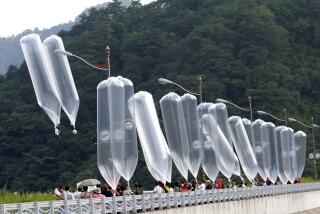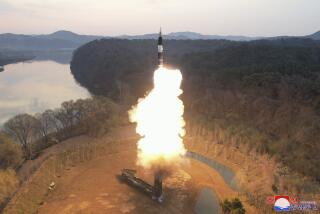Intelligence Agencies in a Swamp of Doubt
- Share via
On Wednesday, diplomats from six nations will convene in Beijing in the most ambitious attempt to date to resolve the festering North Korean nuclear crisis. Among the crucial questions to ask: What nuclear capabilities does Pyongyang have? What can it produce and when? And how can the United States judge North Korea’s answers?
Enter the American intelligence process. But after the controversial estimates of Iraq’s weapons of mass destruction, will the intelligence community be able to deal with these questions, and with what degree of confidence?
For many reasons, political ones not the least, the community’s track record does not offer much encouragement.
Divining North Korea’s nuclear intentions and capabilities has been among the longest-running and most daunting challenges facing the intelligence community. As early as the Reagan administration there were intensive efforts to glean information from the very limited data from this most secretive of societies.
However, intelligence assessments rarely provide definite conclusions. They are approximations, couched in uncertainty and laden with assumptions and caveats. They are part science, part art, part detective work and part consensus-building among analysts and agencies. All too often they are also politically charged.
In October 2002, American officials for the first time accused North Korea of undertaking a covert uranium enrichment program that contravened Pyongyang’s nonproliferation commitments. The Bush administration viewed these findings as a deal-breaker with respect to the 1994 U.S.-North Korea Agreed Framework, which froze the North’s plutonium production and reprocessing activities at Yongbyon in exchange for two light-water reactors and heavy fuel oil.
U.S. officials based their October accusations on a national intelligence estimate, or NIE, completed the previous summer. These documents draw on the pooled knowledge and judgment of the entire intelligence community.
In the 1990s, there were many estimates focused on the North’s production and reprocessing of weapons-grade plutonium but very few addressing Pyongyang’s capability to enrich uranium. (Plutonium is the alternative fissile material to highly enriched uranium in weapons production.) The intelligence community regularly asserted that North Korea had reprocessed enough plutonium in the late 1980s and early 1990s to be able to manufacture one or possibly two nuclear weapons.
However, that community never stated (at least in its public documents) that Pyongyang had manufactured any nuclear weapons. Senior Clinton administration officials consistently claimed that the U.S. was unable to determine whether North Korea had manufactured nuclear weapons with its reprocessed plutonium.
Yet, in December 2001, a declassified NIE concluded that “the intelligence community judged in the mid-1990s that North Korea had produced one, possibly two nuclear weapons.” This was the first time that a declassified U.S. intelligence document made such an assertion.
A second estimate, released to Congress in November 2002, placed these weapons even earlier, claiming that “the U.S. has assessed since the early 1990s that the North has one or possibly two [nuclear] weapons.”
Finally, in a July 30 interview on PBS’ “NewsHour,” National Security Advisor Condoleezza Rice asserted that “before the ink was dry on the [Agreed Framework], they [the North Koreans] were seeking another route to a nuclear weapon, a highly enriched uranium route.”
These claims are highly troubling. References to the early and mid-1990s and to North Korean efforts to acquire enriched uranium immediately after the signing of the Agreed Framework all coincide with the Clinton administration’s tenure. However, none of the routinely declassified CIA reports published since the latter 1990s, or those since the 2001 NIE, lends credence to any of these claims. Remember, the NIEs, by contrast, are the products of the community’s collective judgment, and are frequently mandated by policymakers.
The most recent CIA document, dated April 2003, acknowledges that “we continue to monitor and assess North Korea’s nuclear weapons efforts which, given the North’s closed society and the obvious covert nature of the program, remains a difficult intelligence collection target.” It does not even attempt to characterize the plutonium program.
Are we to believe that the intelligence community withheld critical findings from senior defense officials and from the U.S. Congress, or that the Clinton administration was fully informed of these findings but decided not to disclose them? Is it plausible to assume that such devastating judgments (even as the Clinton administration undertook major efforts to fashion a nuclear accord with North Korea) would not have leaked for a full decade?
Alternatively, are these recent claims attributable to sloppy language or to a selective rendering of the language of earlier estimates? Or has the intelligence community permitted a misrepresentation of the record?
These questions demand answers. Nothing less than the integrity of the U.S. intelligence process is at stake.
Does the community, already reeling from controversies surrounding the Iraq WMD estimates, want its credibility further challenged, even as Pyongyang edges ever closer to declaring itself a nuclear-armed power?
Jonathan D. Pollack is chairman of the Strategic Research Department at the Naval War College. These are his personal views and not those of the War College or the U.S. government.
More to Read
Sign up for Essential California
The most important California stories and recommendations in your inbox every morning.
You may occasionally receive promotional content from the Los Angeles Times.










